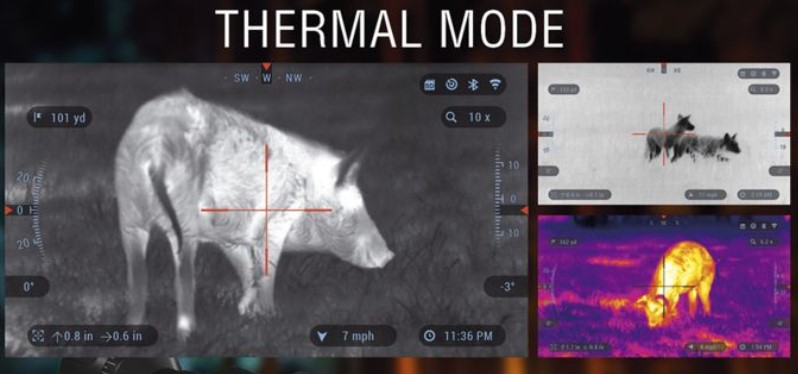How far can you shoot with a thermal scope? Thermal scope detection range will differ from one scope to another with high-end thermal scopes having a range up to 4000 yards while most entry-level scopes will do up to 1000 yards.
Best Thermal Scopes Detection Ranges
- ATN Thor 5 XD -3400 yards
- ATN ThOR 4 7-28x75mm Rifle Scope– 3000 m/3280.84 yards
- ATN ThOR-HD 5-50x 50 mm Rifle Scope– 2500 m /2734 yards
- Pulsar Thermion XG50 Rifle Scope– 2194 m/2400 yds
- Pulsar Trail 2 LRF XP50 Rifle Scope– 1801 m/1970 yds
- Steiner optics Nighthunter S35 1-8x Rifle Scope– 1800 m / 1968 yards
- ATN ThOR 4 4.5-18x50mm Rifle Scope– 1800 m / 1968 yards
- ATN ThOR 4 1.5-15x25mm Rifle Scope – 1050 m/ 1148 yards
- ATN ThOR 4 1.25-5x19mm Rifle Scope – 750 m / 820 yards
Unlike traditional night vision devices that amplify available light, thermal scopes use a microbolometer sensor to detect heat signatures emitted by living things, vehicles, or objects. This makes them incredibly effective in complete darkness, through smoke, fog, or even light foliage.
The thermal scope translates these heat signatures into a visual image (thermogram), usually in grayscale or color palettes, allowing you to see what would otherwise be invisible.
Thermal scope capability makes them highly versatile and suitable for multiple applications, such as hunting, home surveillance, and law enforcement.
When shopping for a thermal scope, you’ll want to know how far you can shoot with it. With thermal scopes, the detection range varies from one scope to the other. A scope can help you identify a target that’s far away, but you must first recognize what it is before you can make the shot.
The detection and recognition distance varies greatly depending on the weather conditions and the size and posture of the target. To help you get a better understanding of how far you can shoot with a thermal scope, let’s take a look at some of the important factors that affect a thermal scope’s detection and recognition range.
Factors that Affect a Thermal Scope’s Detection Range
Resolution
In other words, a thermal scope’s resolution defines its sensitivity, or the microbolometer’s ability to detect infrared radiation. A high resolution, such as 640×480 pixels, results in more detail in the thermal image, allowing for greater differentiation, and detection of objects at a further distance than say 384×288 pixels. It’s good to note that the capability of the sensor may determine the price of the scope.
Objective Lens
Larger objective lens also provides a stronger ability to receive infrared radiation for high-quality image views. It’s also much simpler to recognize a target that’s far away with a large objective lens without losing its imagery quality. However, larger lenses also mean a bulkier, possibly less manageable scope
Magnification
Magnification will affect how far you can shoot with the thermal scope. Variable magnification will help you adapt to different shooting ranges. Higher magnification allows for better target identification at longer distances but can narrow the field of view.
Environmental Conditions
Weather conditions like rain or fog can degrade thermal imaging and reduce the effective distance you can shoot with your thermal scope. In clear conditions, you’ll achieve the maximum range potential of your scope.
Lens Quality
High-quality lenses gather more infrared radiation, which can enhance image quality and extend the detection range. Scopes from ATN like the ATN Thor 5 XD have a very high-quality lens which gives it a detection range of 3400 yards
Shooter Skill and Firearm
Even the best thermal scope is only as good as the person using it. Marksmanship, familiarity with the scope, and the quality of your rifle and ammunition all influence how far you can effectively shoot.
See Also: How Long do ATN Night Vision Scopes Last?
Final Thoughts
How far you can shoot with a thermal scope or the thermal scope detection range will differ from one scope to another. While some high-end thermal scopes might theoretically offer detection at over a mile, practical shooting for hunting or tactical scenarios typically tops out at several hundred yards where precision and target identification remain reliable. As technology evolves, however, these distances may expand.
Related
